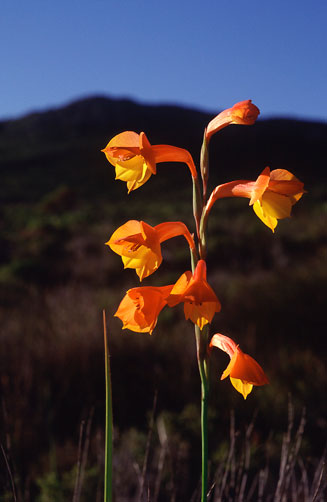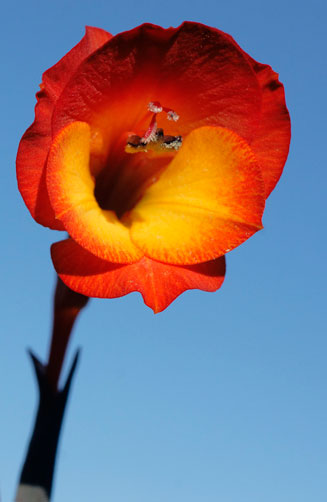|
Gladiolus bonaspei Life
> eukaryotes >
Archaeoplastida >
Chloroplastida
>
Charophyta > Streptophytina > Plantae (land plants)
> Tracheophyta (vascular plants) > Euphyllophyta > Lignophyta (woody plants)
> Spermatophyta (seed plants) > Angiospermae (flowering
plants) > Monocotyledons > Order: Asparagales
> Family: Iridaceae > Genus:
Gladiolus
 |
 |
|
The southern Cape Peninsula endemic, Gladiolus
bonaspei, flowering in winter, South Africa. [photos
Colin Paterson-Jones ©] |
Information is from Goldblatt and Manning (1998).
Identification
- Orange-red, rarely yellow, flowers, with ovate, nearly equal sized,
tepals.
- Elongate perianth tube, slender basally, with a distal broad, round
tube, oriented more-or-less horizontally.
- Leaves with soft, short, errect hairs (i.e. pubescent).
Gladiolus
overbergensis looks similar but tepals are clearly unequal in size
(lower tepals smaller than upper tepals) and leaves are rough haired (scabrid)
rather than soft haired (pubescent).
Distribution and habitat
Endemic to the Cape Peninsula, Western Cape, South Africa,
where it occurs on the sandy plains south of Klaasjagersberg, on the Redhill
Plateau and on the Silvermine Plateau.
Life cycle
- A geophyte with corm measuring 15-20 mm in diameter.
- Flowers mainly from July to September but can flower as early as April.
- Seeds are 8-10 mm long by 6-7 mm wide, broadly winged.
Ecological interactions
Pollinator
The orange-red flower with elongate perianth tube suggest
that this plant is pollinated by sunbirds but there are no confirmed records.
Publications
- Goldblatt P. and Manning J. 1998. Gladiolus in Southern Africa.
Fernwood Press, Vlaeberg, Cape Town.
Text by Hamish Robertson |
